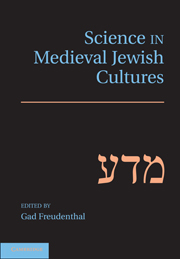Book contents
- Frontmatter
- Contents
- Contributors
- Preface and Acknowledgments
- Introduction: The History of Science in Medieval Jewish Cultures
- Part I The Greek-Arabic Scientific Tradition and Its Appropriation, Adaptation, and Development in Medieval Jewish Cultures, East and West
- Part II Individual Sciences as Studied and Practiced by Medieval Jews
- 5 Logic in Medieval Jewish Culture
- 6 Astronomy among Jews in the Middle Ages
- 7 Interactions between Jewish and Christian Astronomers in the Iberian Peninsula
- 8 The Hebrew Mathematics Culture (Twelfth–Sixteenth Centuries)
- 9 Mathematical and Physical Optics in Medieval Jewish Scientific Thought
- 10 The Evolution of the Genre of the Philosophical-Scientific Commentary
- 11 Latin Scholastic Influences on Late Medieval Hebrew Physics
- 12 Meteorology and Zoology in Medieval Hebrew Texts
- 13 The Mental Faculties and the Psychology of Sleep and Dreams
- 14 Toward a History of Hebrew Astrological Literature
- 15 Astrology in Medieval Jewish Thought (Twelfth–Fourteenth Centuries)
- 16 Astral Magic and Specific Properties (Segullot) in Medieval Jewish Thought
- 17 Medicine among Medieval Jews
- 18 Alchemy in Medieval Jewish Cultures
- 19 The Science of Language among Medieval Jews
- Part III Scientific Knowledge in Context
- Name Index*
- Subject Index*
- References
8 - The Hebrew Mathematics Culture (Twelfth–Sixteenth Centuries)
from Part II - Individual Sciences as Studied and Practiced by Medieval Jews
Published online by Cambridge University Press: 05 June 2012
- Frontmatter
- Contents
- Contributors
- Preface and Acknowledgments
- Introduction: The History of Science in Medieval Jewish Cultures
- Part I The Greek-Arabic Scientific Tradition and Its Appropriation, Adaptation, and Development in Medieval Jewish Cultures, East and West
- Part II Individual Sciences as Studied and Practiced by Medieval Jews
- 5 Logic in Medieval Jewish Culture
- 6 Astronomy among Jews in the Middle Ages
- 7 Interactions between Jewish and Christian Astronomers in the Iberian Peninsula
- 8 The Hebrew Mathematics Culture (Twelfth–Sixteenth Centuries)
- 9 Mathematical and Physical Optics in Medieval Jewish Scientific Thought
- 10 The Evolution of the Genre of the Philosophical-Scientific Commentary
- 11 Latin Scholastic Influences on Late Medieval Hebrew Physics
- 12 Meteorology and Zoology in Medieval Hebrew Texts
- 13 The Mental Faculties and the Psychology of Sleep and Dreams
- 14 Toward a History of Hebrew Astrological Literature
- 15 Astrology in Medieval Jewish Thought (Twelfth–Fourteenth Centuries)
- 16 Astral Magic and Specific Properties (Segullot) in Medieval Jewish Thought
- 17 Medicine among Medieval Jews
- 18 Alchemy in Medieval Jewish Cultures
- 19 The Science of Language among Medieval Jews
- Part III Scientific Knowledge in Context
- Name Index*
- Subject Index*
- References
Summary
In this chapter, I provide a definition of Hebrew mathematical culture, an overview of the periods and persons of medieval Hebrew mathematics, a survey of the bodies of knowledge of Hebrew mathematics, and a discussion of the notion of “Hebrew mathematics.”
DEFINITION AND SCOPE
I apply the term “Hebrew mathematical text” to any text or work whose language is Hebrew and whose content is strictly mathematical. This narrow definition excludes astronomy (apart from some relevant mathematical sections), astrology, and calendar calculations. Two other groups of texts that I do not consider are the biblical and rabbinic literature and mathematical texts written by Jewish scholars in Arabic.
The arithmetical or geometrical passages in the biblical and rabbinic literature (notably the Mishnah and Talmud) are certainly Hebrew mathematics; however, they are relatively sparse and unsystematic and have a meaning only in the context of the problems (practical, legal, liturgical) that inspired them. One could certainly attempt to attach this material to the traditions of Babylonian or Egyptian mathematics or even to specific Greek traditions. Yet I must underscore that the corpus of writings in which we are interested here – the first mathematical writings in Hebrew to be considered date from the twelfth century – are not a development of this knowledge, although it was also presented in Hebrew (and sometimes in Aramaic). It is important to emphasize this discontinuity of nature and not only of form that distinguishes rabbinic mathematics from the medieval texts to be considered. Yet, as historians have pointed out, medieval Jewish scholars themselves went out of their way to emphasize the continuity between these two bodies of knowledge as a means of legitimizing their own scientific activity:Doing so allowed them to find a place for the profane sciences within the context of the community culture, the essential glue and guarantor of the continuity of the Jewish culture. Similarly, the medieval Hebrew mathematical vocabulary (see the later discussion on Abraham bar H. iyya and Abraham Ibn Ezra) was created by exploiting linguistic resources available in the ancient texts
- Type
- Chapter
- Information
- Science in Medieval Jewish Cultures , pp. 155 - 171Publisher: Cambridge University PressPrint publication year: 2012



